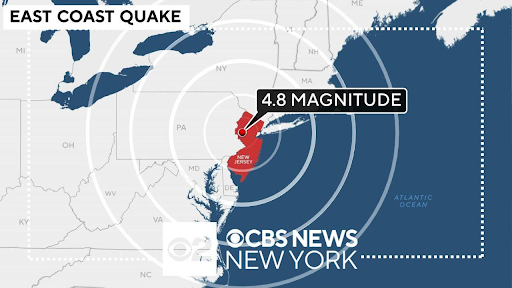Natural disasters are becoming increasingly common, but the idea of an earthquake hitting New York is one that brings light to the evergrowing dynamics of our world. On April 5th, 2024, a 4.8 magnitude earthquake hit near the Whitehouse Station, New Jersey, but was felt across Connecticut, the Big Apple, and other parts of New Jersey. The event did not stop there, according to 4.0-magnitude aftershock felt in NYC by Finn Hoogensen, “A 4.0-magnitude aftershock was felt in New York City Friday evening,” hours later. The aftershock was centered around Gladstone, NJ; yet, it spanned other regions in the area. The phenomenon shocked many New Yorkers as the tri state area usually does not experience earthquakes at the magnitude indicated. To better understand the event, Professor Dax Soule of the Environmental Science & Studies department at Queens College weighed in on what this earthquake means for our future, as well as the uniqueness behind it. Professor Soule is an assistant professor who is a geophysicist, his specialty aligns with solid earth geophysics, cloud computing, oceanography, and STEM education. Professor Soule dived into the factors that contributed to the natural disaster by providing an analysis of the bedrock on the East Coast of North America.
He explained that the bedrock in this region contains old rocks that are classed as “cold and dense.” Professor Soule added that, “These rocks have many fractures that, in some cases, can move relative to each other… energy is released, and we feel the earthquake. The big thing to recognize is that, because of how old and cold the bedrock is, this energy travels very well and can be felt a long way from the location of the earthquake.” The East Coast of North America is noted to have an interesting geological history that has many layers to it. Soule’s explanation provides significant details on the formulation of earthquakes; however, there are other important details to note. The East Coast has always been seismically active. Perhaps we do not hear about it as much as countries on the Ring of Fire (Japan and Taiwan are examples), but we have had smaller earthquakes that are not noticed, as they are not as “large.” With this information, Professor Soule concluded that “there are no new trends in seismic activity in the NYS area.” However, New York will be experiencing more earthquakes, and this one should not be considered a one time incident. Most of the earthquakes will be rather small, but there are instances where larger damage might occur, as stated by Professor Soule. This means that older establishments might be in danger if larger earthquakes happen. Additionally, these earthquakes could impact people close to home in the NYC region. “Queens and Long Island are particularly vulnerable because our structures are built on glacial sediments instead of bedrock,” emphasized Soule in his analysis. Even though the New York region might not be plagued by earthquakes, there are useful tools around to monitor activity.
There are various seismic stations on the East Coast, with one being at Queens College. Professor Soule noted that “The USGS manages an early warning system called ShakeAlert that will detect an earthquake and estimate its location, magnitude, and shaking intensity. Warnings from this system can prompt people to use the available moments to protect themselves.” There are safety parameters in place around the East Coast and locally to help understand earthquake activity in the area, even with the concerns that earthquakes bring. With the likelihood of earthquakes increasing in the New York area, small or big, it is a great time to understand how earthquakes impact us locally and in a global sense. The USGS database provides an abundance of information on the topic that relate to recent earthquakes and detailed research on the various regions across the United States. Professor Soule expressed that there are more opportunities for students interested in the field. He stated, “If you are a student at Queens College, you can enroll in the class ‘Earthquakes, Volcanoes and Moving Continents,’ being taught in fall 2024!” Even though the recent earthquake may have caught many people by surprise, it is a reminder of the forgotten geological dynamics worldwide. With the likelihood of increased earthquakes, it’s critical to utilize all available information to best analyze and prepare for future events, both on the local and global scale.











